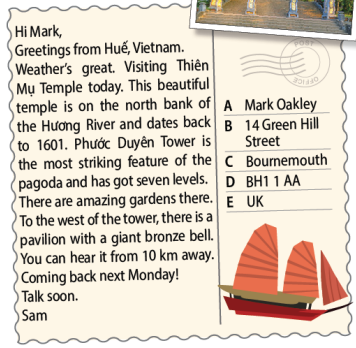2. Fill in each gap with guard, stadium, mausoleum, tomb or statues.
(Điền vào chỗ trống các từ: bảo vệ, sân vận động, lăng. mộ và tượng.)
1. The Taj Mahal is a _____ in India.
2. There are lots of _____ in the museum.
3. The Great Pyramid of Giza in Egypt is a _____ for Pharaohs.
4. The stupa in Trấn Quốc Temple has got six gates. Figures of Amitabha _____ them.
5. The Colosseum is an ancient _____ in Italy.
|
1. mausoleum |
2. statues |
3. tomb |
4. guard |
5. stadium |
1. The Taj Mahal is a mausoleum in India.
(Taj Mahal là lăng ở Ấn Độ.)
2. There are lots of statues in the museum.
(Có nhiều bức tượng ở trong bảo tàng.)
3. The Great Pyramid of Giza in Egypt is a tomb for Pharaohs.
(Đại kim tự tháp Giza ở Ai Cập là một lăng mộ của các Pharaoh.)
4. The stupa in Trấn Quốc Temple has got six gates. Figures of Amitabha guard them.
(Bảo tháp ở đền Trấn Quốc có sáu cửa. Các bức hình của A Di Đà dùng để trấn giữ chúng.)
5. The Colosseum is an ancient stadium in Italy.
(Đấu trường La Mã là một sân vận động cổ ở Ý.)

Các bài tập cùng chuyên đề
1. Read the task. Underline the key words and answer the questions.
(Đọc các câu hỏi. Gạch chân dưới từ khóa và trả lời các câu hỏi.)
|
Imagine you are on holiday visiting a wonder. Write a postcard to your English penfriend (about 60-80 words). Include where you are, the information about the wonder and when you are coming back. |
1. What are you going to write?
2. Who is going to read it?
3. What is it going to be about?
4. How many words are you going to write about?
Model analysis
2. Read the model. Which adjectives does Sam use to describe
(Đọc bài mẫu. Sam đã sử dụng những tính từ gì để miêu tả)
- the temple?
(đền)
- the gardens?
(vườn)
- the bell?
(chuông)







